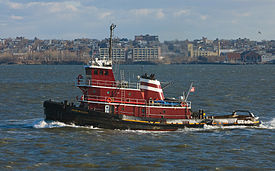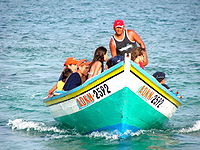
Boat
Did you know...
This Wikipedia selection is available offline from SOS Children for distribution in the developing world. Child sponsorship helps children one by one http://www.sponsor-a-child.org.uk/.
A boat is a watercraft designed to float or plane on water, and provide transport over it. Usually this water will be inland (lakes) or in protected coastal areas. However, boats such as the whaleboat were designed to be operated from a ship in an offshore environment. In naval terms, a boat is something small enough to be carried aboard another vessel (a ship). Some boats too large for the naval definition include the Great Lakes freighter, riverboat, narrowboat and ferryboat. Modern submarines can also be called boats, despite their underwater capabilities and size. This may be because the first submarines could be carried by a ship and were not capable of making independent offshore passages. Boats may be used by the military or other government interests, or for research or commercial purposes; but regardless of size, a vessel in private, non-commercial usage is almost certainly a boat.
History
The oldest recovered boat in the world is the canoe of Pesse; it is a dugout or hollowed tree trunk from a Pinus sylvestris. According to C14 dating analysis it has been constructed somewhere between 8200 and 7600 B.C. This canoe is exhibited in the Drents Museum in Assen, Netherlands.
Boats have served as a method for short distance transportation since early times, on slow rivers and calm seas. Circumstantial evidence, such as the early settlement of Australia over 40,000 years ago, suggests that boats have been used since very ancient times. The earliest boats have been predicted to be logboats, or possibly boats made from hide or tree bark. The oldest boats to be found by archaeological excavation are logboats from around 7000-9,000 years ago, though a 7000 year-old seagoing boat made from reeds and tar has been found in Kuwait.
Being more capacious than carts and wagons, and suitable for both slow rivers and calm seas, boats were used between 4000BCE-3000BCE in Sumer, Ancient Egypt and in the Indian Ocean.
Boats played an important part in the commerce between the civilizations of Indus Valley and Mesopotamia. Evidence of varying models of boats has also been discovered in various Indus Valley sites.
The accounts of Historians Herodotus, Pliny the elder and Strabo, suggest that boats were being used for commerce and traveling.
Types

Unusual boats have been used for sports purposes such as bathtub racing, which use boats made from bathtubs. Pumpkins have also been used as boats in Pumpkin Boat Races.
Parts and terminology
Common to most boats are several key components which make up the main structure of the boat. The hull is the main structural component of the boat which provides buoyancy for the boat. The roughly horizontal, but cambered structures spanning the hull of the boat are referred to as the deck. In a ship there are often several decks, but a boat is unlikely to have more than one. Above the deck are the superstructures. The underside of a deck is the deck head.
An enclosed space on a boat is referred to as a cabin. Several individual structures make up a cabin: the similar but usually lighter structure which spans a raised cabin is a coach-roof. The "floor" of a cabin is properly known as the sole, but is more likely to be called the floor (a floor is properly, a structural member which ties a frame to the keelson and keel). The vertical surfaces dividing the internal space are bulkheads.
The keel is a lengthwise structural member to which the frames are fixed (sometimes referred to as a backbone).
The front of a boat is called the bow or prow. Boats of earlier eras often featured a figurehead protruding from the front of the bows. The rear of the boat is called the stern. The right side is starboard and the left side is port.
Building materials

Until the mid 19th century most boats were of all natural materials; primarily wood. Many boats had been built with iron or steel frames but still planked in wood. In 1855 ferro-cement boat construction was patented by yothe French. They called it Ferciment. This is a system by which a steel or iron wire framework is built in the shape of a boat's hull and covered ( troweled) over with cement. Reinforced with bulkheads and other internal structure it is strong but heavy, easily repaired, and, if sealed properly, will not leak or corrode. These materials and methods were copied all over the world, and have faded in and out of popularity to the present. As the forests of Britain and Europe continued to be over-harvested to supply the keels of larger wooden boats, and the Bessemer Process (patented in 1855) cheapened the cost of steel, steel ships and boats began to be more common. By the 1930s boats built of all steel from frames to plating were seen replacing wooden boats in many industrial uses, even the fishing fleets. Private recreational boats in steel are uncommon. In the mid 20th century aluminum gained popularity. Though much more expensive than steel, there are now aluminum alloys available that will not corrode in salt water, and an aluminium boat built to similar load carrying standards could be built lighter than steel. Nonetheless, boats are generally built in such a manner as to keep water from invading the hull, which would cause the boats to sink.
Around the mid 1960s, boats made out of glass-reinforced plastic, more commonly known as fibreglass, became popular, especially for recreational boats. The coast guard refers to such boats as 'FRP' (for Fiberglass Reinforced Plastic) boats. Fiberglass boats are extremely strong, and do not rust (iron oxide), corrode, or rot. They are, however susceptible to structural degradation from sunlight and extremes in temperature over their lifespan. Fiberglass provides structural strength, especially when long woven strands are laid, sometimes from bow to stern, and then soaked in epoxy or polyester resin to form the hull of the boat. Whether hand laid or built in a mold, FRP boats usually have an outer coating of gelcoat which is a thin solid colored layer of polyester resin that adds no structural strength, but does create a smooth surface which can be buffed to a high shine and also acts as a protective layer against sunlight. FRP structures can be made stiffer with sandwich panels, where the FRP encloses a lightweight core such as balsa or foam. Cored FRP is most often found in decking which helps keep down weight that will be carried above the waterline. The addition of wood makes the cored structure of the boat susceptible to rotting which puts a greater emphasis on not allowing damaged sandwich structures to go unrepaired. Plastic based foam cores are less vulnerable. The phrase 'advanced composites' in FRP construction may indicate the addition of carbon fibre, kevlar(tm) or other similar materials, but it may also indicate other methods designed to introduce less expensive and, by at least one yacht surveyor's eyewitness accounts , less structurally sound materials.
Cold molding is similar to FRP in as much as it involves the use of epoxy or polyester resins, but the structural component is wood instead of fibreglass. In cold molding very thin strips of wood are laid over a form or mold in layers. This layer is then coated with resin and another directionally alternating layer is laid on top. In some processes the subsequent layers are stapled or otherwise mechanically fastened to the previous layers, but in other processes the layers are weighted or even vacuum bagged to hold layers together while the resin sets. Layers are built up thus to create the required thickness of hull.
People have even made their own boats or watercraft out of commonly available materials such as styrofoam or plastic, but most homebuilts today are built of plywood and either painted or covered in a layer of fibreglass and resin.
Propulsion
The most common means are:
- Human power (rowing, paddling, setting pole etc.)
- Wind power ( sailing)
- Motor powered screws
- Inboard
- Internal Combustion (gasoline, diesel, heavy fuel oil)
- Steam (Coal, fuel oil)
- Nuclear (for submarines and large naval ships)
- Inboard/Outboard
- Gasoline
- Diesel
- Outboard
- Gasoline
- Electric
- Paddle Wheel
- Water Jet ( Jet ski, Personal water craft, Jetboat)
- Air Fans (Hovercraft, Air boat)
- Inboard
Buoyancy
A boat stays afloat because its weight is equal to that of the water it displaces. The material of the boat itself may be heavier than water (per volume), but it forms only the outer layer. Inside it is air, which is negligible in weight. But it does add to the volume. The central term here is density, which is mass ('weight') per volume. The mass of the boat (plus contents) as a whole has to be divided by the volume below the waterline. If the boat floats, then that is equal to the density of water (1 kg/l). To the water it is as if there is water there because the average density is the same. If weight is added to the boat, the volume below the waterline will have to increase too, to keep the mass/weight balance equal, so the boat sinks a little to compensate.




